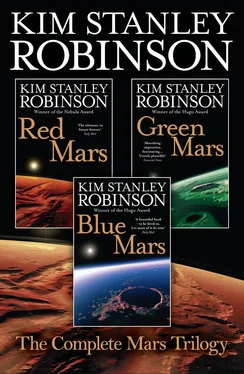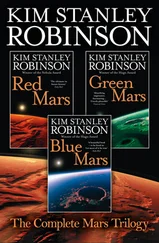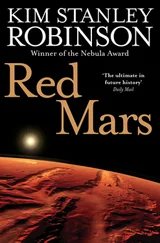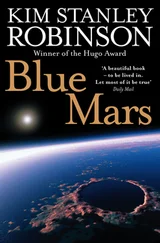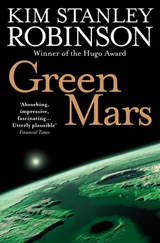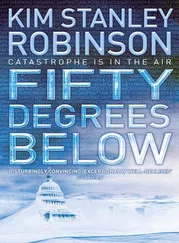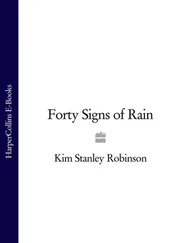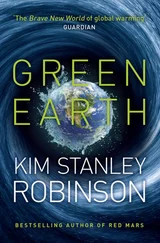“But that was sixty million years ago,” Nadia said. “It would be buried under the ice.”
“True.” Later, walking back to the rover, she said, “Well, if they melt these caps then we’ll find some. We’ll have a whole museum of meteorites, sitting around on the sand.”
They crossed more swirl valleys, falling again into the up-and-down pattern of a boat over waves, this time the largest waves yet, forty kilometers from crest to crest. They used the clocks to keep on a schedule, and parked from ten p.m. to five a.m. on hillocks or buried crater rims, to give themselves a view during their stops; and they blacked the windows with double polarization to help them to get some sleep at night.
Then one morning as they crunched along, Ann turned on the radio and began to run checks with the areosynchronous satellites. “It’s not easy to find the pole,” she said as she worked. “The early Terran explorers had a hell of a time in the north: they were always up there in summertime and couldn’t see the stars, and they had no satellite checks.”
“So how did they do it?” Nadia asked, suddenly curious.
Ann thought about it and smiled. “I don’t know. Not very well, I suspect. Probably dead reckoning.”
Nadia became intrigued by the problem, and started working on it on a sketchpad. Geometry had never been her strong point, but presumably at the north pole on midsummer’s day, the sun would inscribe a perfect circle around the horizon, never getting higher or lower. If you were near the Pole, then, and it was near Midsummer’s Day, you might be able to use a sextant to make timed checks on the sun’s height above the horizon … was that right?
“This is it,” Ann said.
“What?”
They stopped the rover, looked around. The white plain undulated to the nearby horizon, featureless except for a couple of broad red contour lines; the lines did not form bull’s eyes circles around them, and it didn’t look like they were at the top of anything.
“Where, exactly?” Nadia asked.
“Well, somewhere just north of here.” Ann smiled again. “Within a kilometer or so. Maybe that way.” She pointed off to the right. “We’ll have to go over there a ways and check with the satellite again. A little bit of triangulation and we should be able to hit it on the nose. Plus or minus a hundred meters, anyway.”
“If we just took the time, we could make it plus or minus a meter!” Simon said enthusiastically. “Let’s pin it down!”
So they drove for a minute, consulted the radio, turned to right angles and drove again, made another consultation. Finally Ann declared they were there, or close enough. Simon programmed the computer to keep working on it, and they suited up and went out and wandered around a bit, to make sure they had stepped on it. Ann and Simon drilled a boring. Nadia kept walking, in a spiral that expanded away from the cars. A reddish white plain, the horizon some four kilometers away; too close; it came to her in a rush, as during the black dune sunset, that this was alien – a sharp awareness of the tight horizon, the dreamy gravity, a world just so big and no bigger … and now she was standing right on its north pole. It was Ls = 92, about as near midsummer as you could ask; so if she stood facing the sun, and didn’t move, the sun would stay right in front of her face for all the rest of the day, or the rest of the week for that matter! It was strange. She was spinning like a top. If she stood still long enough, would she feel it?
Her polarized faceplate reduced the sun’s glare on the ice to an arc of crystalline rainbow points. It wasn’t very cold. She could just feel a breeze against her upraised palm. A graceful red streak of depositional laminae ran over the horizon like a longitude line. She laughed at the thought. There was a very faint ice-ring around the sun, big enough that its lower arc just touched the horizon. Ice was subliming off the polar cap and gleaming in the air above, providing the crystals in the ring. Grinning, she stomped her boot prints into the North Pole of Mars.
That evening they aligned the polarizers so that a very dimmed-down image of the white desert stood around them in the module windows. Nadia sat back with an empty food tray in her lap, sipping a cup of coffee. The digital clock flicked from 11:59:59 to 0:00:00, and stopped. Its stillness accentuated the quietness in the car. Simon was asleep; Ann sat in the driver’s seat, staring out at the scene, her dinner half-eaten. No sound but the whoosh of the ventilator. “I’m glad you got us up here,” Nadia said. “It’s been great.”
“Someone should enjoy it,” Ann said. When she was angry or bitter her voice became flat and distant, almost as if she were being matter-of-fact. “It won’t be here long.”
“Are you sure, Ann? It’s five kilometers deep here, isn’t that what you said? Do you really think it will completely disappear just because of black dust on it?”
Ann shrugged. “It’s a question of how warm we make it. And of how much total water there is on the planet, and how much of the water in the regolith will surface when we heat the atmosphere. We won’t know any of those things until they happen. But I suspect that since this cap is the primary exposed body of water, it’ll be the most sensitive to change. It could sublime away almost entirely before any significant part of the permafrost has gotten within fifty degrees of melting.”
“Entirely?”
“Oh, some will be deposited every winter, sure. But there’s not that much water, when you put it in the global perspective. This is a dry world, the atmosphere is super-arid, it makes Antarctica look like a jungle, and remember how that place used to suck us dry? So if temperatures go up high enough, the ice will sublime at a really rapid rate. This whole cap will shift into the atmosphere and blow south, where it’ll frost out at nights. So in effect it’ll be redistributed more or less evenly over the whole planet, as frost about a centimeter thick.” She grimaced. “Less than that, of course, because most of it will stay in the air.”
“But then if it gets hotter still, the frost will melt, and it will rain. Then we’ve got rivers and lakes, right?”
“If the atmospheric pressure is high enough. Liquid surface water depends on air pressure as well as temperature. If both rise, we could be walking around on sand here in a matter of decades.”
“It’d be quite a meteorite collection,” Nadia said, trying to lighten Ann’s mood.
It didn’t work. Ann pursed her lips, stared out the window, shook her head. Her face could be so bleak; it couldn’t be explained entirely by Mars, there had to be something more to it, something that explained that intense internal spin, that anger. Bessie Smith land. It was hard to watch. When Maya was unhappy it was like Ella Fitzgerald singing a blues, you knew it was a put-on, the exuberance just poured through it. But when Ann was unhappy, it hurt to watch it.
Now she picked up her dish of lasagne, leaned back to stick it in the microwave. Beyond her the white waste gleamed under a black sky, as if the world outside were a photo negative. The clockface suddenly read 0:00:01.
Four days later they were off the ice. As they retraced their route back to Phyllis and George and Edvard, the three travelers rolled over a rise and came to a halt; there was a structure on the horizon. Out on the flat sediment of the chasma floor there stood a classical Greek temple, six Dorian columns of white marble, capped by a round flat roof.
“What the hell?”
When they got closer they saw that the columns were made of ice drums from the miner, stacked on top of each other. The disk that served as roof was rough-hewn.
“George’s idea,” Phyllis said over the radio.
Читать дальше
